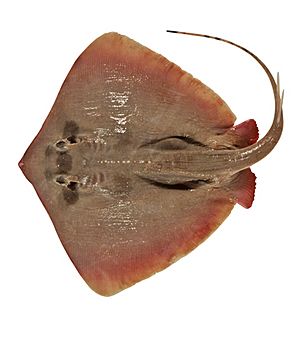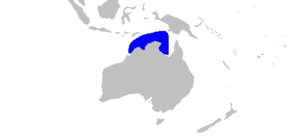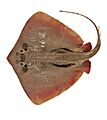Plain maskray facts for kids
Quick facts for kids Plain maskray |
|
|---|---|
 |
|
| Conservation status | |
| Scientific classification | |
| Genus: |
Neotrygon
|
| Species: |
annotata
|
 |
|
| Range of the plain maskray | |
| Synonyms | |
|
|
The plain maskray (Neotrygon annotata), also called the brown stingray, is a type of stingray. It belongs to the Dasyatidae family. You can find it in shallow waters off northern Australia. It likes soft, sandy or muddy places on the ocean floor.
This stingray can grow up to 24 centimeters (about 9.4 inches) wide. It has a flat, diamond-shaped body that is grayish-green. Its tail is short and looks like a whip. The tail has cool black and white stripes. It also has small folds of skin above and below it.
The plain maskray has a few short rows of thorns on its back and near the base of its tail. But most of its skin is smooth. Like other maskrays, it has a dark, mask-like pattern around its eyes. However, it's not as fancy or colorful as some other maskrays.
This stingray mostly eats small shrimp and worms that live on the ocean floor. Sometimes, it also eats small fish. Female plain maskrays give birth to one or two live young. The babies grow inside the mother and get food from her.
Sadly, plain maskrays are sometimes caught by accident in large fishing nets called bottom trawls. Because they are not very strong, they often don't survive this. They also don't have many babies and live in a small area. Because of these reasons, the International Union for the Conservation of Nature (IUCN) says the plain maskray is "Near Threatened". This means it could become endangered if we don't protect it.
Contents
About the Plain Maskray Name
The plain maskray was first described by a scientist named Peter R. Last in 1987. He worked for the Commonwealth Scientific and Industrial Research Organisation (CSIRO). The name annotatus comes from Latin words meaning "not marked." This refers to the ray's simple color pattern.
At first, this stingray was placed in a different group called Dasyatis. But later, in 2008, scientists decided it belonged to a new group called Neotrygon. This group includes other "maskrays" like the bluespotted stingray. Scientists made this change after studying the rays' bodies and their DNA.
What the Plain Maskray Looks Like
The plain maskray has a thin, diamond-shaped body. Its outer corners are gently rounded. The front edges of its body curve inward to a pointy snout. Its small eyes are close together. Behind its eyes are two small holes called spiracles.
Its nostrils are long, and there's a small flap of skin between them. The mouth is small and has small bumps, called papillae, inside and around it. It also has five pairs of gill slits, which it uses to breathe. The fins on its belly, called pelvic fins, are quite large and pointed.
The tail of the plain maskray is short, usually not much longer than its body. It has a wide, flat base. Most plain maskrays have two stinging spines on their tail. After the stings, the tail becomes thinner. It has a long fold of skin underneath and a shorter one on top.
Most of the plain maskray's body is smooth. But it has a row of 4 to 13 small thorns down the middle of its back, behind its spiracles. It might also have a few thorns near its tail stings.
The top of the plain maskray is grayish-green. It gets a bit pinker towards the edges of its body. It has a dark, mask-like shape around its eyes. There are also two small dark spots behind its spiracles. The tail, past the stings, has black and white stripes. The tip of the tail is black. The underside of the ray is plain white. This stingray can grow up to 24 cm (about 9.4 inches) wide and 45 cm (about 17.7 inches) long.
Where the Plain Maskray Lives
The plain maskray lives on the continental shelf off northern Australia. This includes areas like the Gulf of Carpentaria and the Timor Sea. Some people think it might also live near southern Papua New Guinea, but this is not confirmed.
This stingray is a bottom-dweller. It likes places with fine sand or mud. It has been found in waters between 12 and 62 meters (about 39 to 203 feet) deep. It tends to live farther from the shore than other maskrays in its area.
Plain Maskray Life and Diet
The plain maskray usually hunts for food on the surface of the ocean floor. It doesn't dig deep into the sand. Its main foods are shrimp and worms. It also eats small bony fish and sometimes other small sea creatures like prawns. Bigger plain maskrays tend to eat more different kinds of food, especially more worms.
Reproduction and Life Cycle
Like other stingrays, the plain maskray gives birth to live young. The baby rays grow inside the mother. They are fed by a special "uterine milk" produced by the mother. Female plain maskrays have one working ovary and uterus, both on the left side.
They usually give birth to one or two babies at a time. Newborn plain maskrays are about 12 to 14 cm (about 4.7 to 5.5 inches) wide. Males become old enough to reproduce when they are about 20 to 21 cm (about 7.9 to 8.3 inches) wide. Females are ready when they are about 18 to 19 cm (about 7.1 to 7.5 inches) wide. Males can live for about 9 years, and females can live for about 13 years.
Plain Maskray and Humans
The biggest danger to the plain maskray is being caught by accident in fishing nets. This often happens with large commercial fishing boats that use bottom trawls. These nets drag along the ocean floor. Even though plain maskrays are usually thrown back into the ocean when caught, they are very delicate. This means they often don't survive being caught in the nets.
In the past, fishing boats from Japan, China, and Taiwan also fished a lot off northern Australia. This might have also harmed the plain maskray population. Because of these dangers, along with its small living area and low number of babies, the International Union for Conservation of Nature (IUCN) has listed the plain maskray as "Near Threatened".
Images for kids




